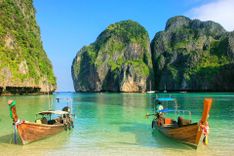Wat Phra That Doi Suthep
Opposite a car park and souvenir village, a flight of three hundred naga-flanked steps – or the adjacent cable car – is the last leg on the way to Wat Phra That Doi Suthep. From the temple’s lower terrace, the magnificent views of Chiang Mai and the surrounding plain, 300m below, are best in the early morning or late afternoon in the cool season, though peaceful contemplation of the view is frequently shattered by people sounding the heavy, dissonant bells around the terrace – they’re supposed to bring good luck. At the northwestern corner is a 2m-high statue of the elephant which, so the story goes, expired on this spot.
Before going to the upper terrace you have to remove your shoes – and if you’re showing a bit of knee or shoulder, the temple provides wraps to cover your impoliteness. This terrace is possibly the most harmonious piece of temple architecture in Thailand, a dazzling combination of red, green and gold in the textures of carved wood, filigree and gleaming metal – even the tinkling of the miniature bells and the rattling of fortune sticks seem to keep the rhythm. A cloister, decorated with gaudy murals, tightly encloses the terrace, leaving room only for a couple of small minor viharns and the altars and ceremonial gold umbrellas which surround the central focus of attention, the chedi. This dazzling gold-plated beacon, a sixteenth-century extension of Ku Na’s original, was modelled on the chedi at Wat Phra That Haripunjaya in Lamphun – which previously had been the region’s most significant shrine – and has now become a venerated emblem of northern Thailand.
A small hong, or swan, on a wire stretching to the pinnacle is used to bless the chedi during major Buddhist festivals: a cup in the swan’s beak is filled with water, and a pulley draws the swan to the spire where the water is tipped out over the sides of the chedi. Look out also for an old photograph opposite the northeastern corner of the chedi, showing a cockerel which used to peck the feet of visitors who entered with their shoes on.
Khruba Srivijaya
Khruba Srivijaya, widely regarded as the “patron saint” of northern Thailand, was born in 1878 in a small village 100km south of Chiang Mai. His birth coincided with a supernatural thunderstorm and earthquake, after which he was given the auspicious nickname Faa Rawng (Thunder) until he joined the monkhood. Appointed abbot of his local temple by the age of 24, he came to be regarded as something of a rebel – though a hugely popular one among the people of Lanna. Despite the suspicions of the Sangha, both locally and in Bangkok, he became abbot of Lamphun’s Wat Chama Thevi, which he set about restoring with gusto. This was the beginning of a tireless campaign to breathe life into Buddhist worship in the north by renovating its religious sites: over a hundred temples got the Khruba treatment, including Chiang Mai’s Wat Phra Singh, Wat Phra That Haripunjaya in Lamphun and Wat Phra That Doi Tung near Mae Sai, as well as bridges, schools and government buildings. His greatest work, however, was the construction in 1935 of the paved road up to Wat Phra That Doi Suthep, which beforehand could only be reached after a climb of at least five hours. The road was constructed entirely by the voluntary labour of people from all over the north, using the most primitive tools. The project gained such fame that it attracted donations of B20 million, and on any one day as many as four thousand people were working on it. So that people didn’t get in each other’s way, Khruba Srivijaya declared that each village should contribute 15m of road, but as more volunteers flocked to Chiang Mai, this figure had to be reduced to 3m. The road was completed after just six months, and Khruba Srivijaya took the first ride to the temple in a donated car.
When Khruba Srivijaya died back in his native village in 1938, Rama VIII was so moved that he sponsored a royal cremation ceremony, held in 1946 (a long wait until the auspicious day for a cremation signifies high respect for the deceased). The monk’s relics were divided up and are now enshrined at Wat Suan Dork in Chiang Mai, Wat Phra Kaeo Don Tao in Lampang and at many other holy places throughout the north. There’s a statue of him at the end of Thanon Huai Kaeo, where the road to Wat Phra That Doi Suthep starts, and you’ll see photos of him in temples, shops and restaurants all over the north, where Khruba amulets are still hugely popular, over seventy years after his death.





